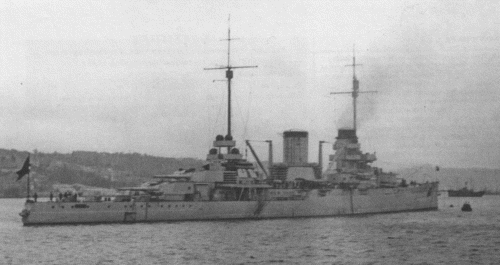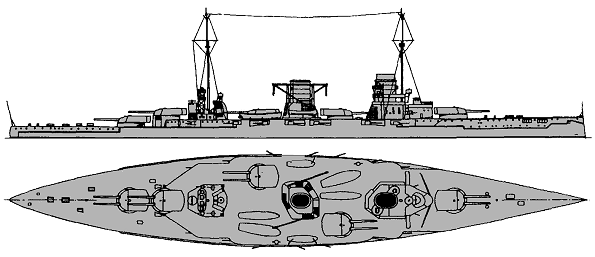
NAVYPEDIA
 Support the project with paypal
Support the project with paypal
Photo

Yavuz 1933
Ships
| Name | No | Yard No | Builder | Laid down | Launched | Comp | Fate |
|---|---|---|---|---|---|---|---|
| Yavuz Sultan Selim (ex-Goeben), 1930- Yavuz Selim, 1936- Yavuz | Blohm & Voss, Hamburg, Germany | 12.8.1909 | 28.3.1911 | 2.7.1912 // 16.8.1914 | stricken 11.1954 |
Technical data
| Displacement normal, t | 22979 |
|---|---|
| Displacement full, t | 25400 |
| Length, m | 185.9 wl 186.6 oa |
| Breadth, m | 29.5 |
| Draught, m | 8.70 |
| No of shafts | 4 |
| Machinery | 4 Parsons steam turbines, 24 Marine (Schultz-Thornycroft) boilers |
| Power, h. p. | 52000 |
| Max speed, kts | 25.5 |
| Fuel, t | coal 3050 |
| Endurance, nm(kts) | 4120(14) |
| Armour, mm | belt: 270, bulkheads: 200, upper belt: 200, main deck: 50 with 50mm slopes, upper deck: 25, turrets: 230, barbettes: 265, casemates: 130, CT: 350 - 200 |
| Armament | 5 x 2 - 283/47 SK L/50 C/09, 12 x 1 - 149/42 SK L/45 C/09, 10 x 1 - 88/42 SK L/45 C/09, 4 - 500 TT (1 bow, 1 stern, 2 beam, 12) |
| Complement | 1053 |
Standard scale images

Yavuz Sultan Selim 1914

Yavuz Sultan Selim 1918

Yavuz 1941
Graphics
Project history
Former German battlecruiser Goeben. She was ordered 8.4.1909 as second ship of Moltke class. To WWI beginning she served on Mediterranean sea, 11.8.1914, together with light cruiser Breslau has come to Dardanelles. To avoid internment, she was offered to Turkish Government to solve a question on purchase of ships. 16.8.1914 Goeben raised Turkish flag and received name Yavuz Sultan Selim though all crew on her remained German. Turkish authorities have stated foreign embassies, that they bought Goeben and Breslau (named Midilli) instead of incomplete Turkish dreadnoughts Reshadiye and Sultan Osman-i Ewel, requisitioned by Great Britain (RN Erin and Agincourt). Goeben was representative of first generation of German battlecruisers with 280mm artillery and strong protection. Designed machinery power was 52000hp, ensured 25.5kts speed. On trials Goeben shown 28kts at 85661hp.
Ship protection
Main 270mm belt was placed between end barbettes and closed by 200mm transverse bulkheads. Above it there was 200mm upper belt, connected with an upper deck, and still above there were 130mm casemates of 150mm guns. Ship ends were protected by 100mm belt. Main armour deck had 50mm thickness and connected with lower edge of main belt by 50mm slopes. 25mm upper deck connected with upper edge of upper belt. Main turrets had 230mm faces and 90mm roofs; barbettes had 265mm protection, fwd CT had 350-250mm sides and 80mm roof, aft CT had 200mm sides and 50mm roof. On all length of the belt ship had 30mm longitudinal torpedo bulkhead (50mm abreast main magazines), dipped from flat part of main deck to double bottom.
Modernizations
1916: - 2 x 1 - 149/42, 2 x 1 - 88/42; + 8 x 1 - 88/45 SK L/45 C/13
(10/1928-3/1930, Gölcük Tersane, Istanbul): boilers were converted to mixed coal / oil burning (22616/25300t, 52000hp, 25.5kts, 2950t coal + 300t oil, 5350(10)nm); - 2 x 1 - 88/45, 8 x 1 - 88/42, 2 - 500 TT (1 bow, 1 stern)
1938: + 10 x 1 - 40/39 2pdr QF Mk VIII, 4 x 1 - 20/65 C/30
1941: + 2 x 1 - 40/39 2pdr QF Mk VIII, 2 x 1 - 20/65 C/30
to 1945: - 6 x 1 - 20/65; + 10 x 1 - 40/56 Bofors Mk I/III, 24 x 1 - 20/70 Oerlikon Mk II/IV
to 1950: - 12 x 1 - 40/39, 20 x 1 - 20/70
Naval service
18.11.1914 in battle at cape Sarych Yavuz Sultan Selim received hit of 305mm shell from battleship Yevstafiy to 150mm casemate. 26.12.1914 she was damaged by two Russian mines at Bosporus, received serious damages, but was repaired. 20.1.1918 off Dardanelles she was damaged by three mines, and at returning ran ashore.
9.11.1918 German crew abandoned the ship, and during following of 9 years she was laid up at Izmit. Under decisions of Lausanne Treaty did not demand her transfer, obviously, considering impossible her restoration in conditions of wrecked economy of Turkey and absence in its territory of dock of eligible sizes. However in 1925 Turkey has concluded contract with Flenderwerft about building of 25000t floating dock specially for repair of a battlecruiser. The dock was installed at Gölcük, where 20.12.1926 Yavuz Sultan Selim was towed in. Restoring repair was conducted by Turkish builder T. C. Deniz Kuvetlari Gölcük Tersane with assistance of Penhoet St. Nazaire since October 1928 till March 1930. Since 1948 Yavuz did not go out to sea; 20.12.1950 she was laid up into reserve; 14.11.1954 she was excluded from fleet lists, however a long time was laid up at Gölcük. In 1963 Government of Federative Republic Germany tried to redeem the ship for transformation to a museum, but in 1970 she was sold on demolition and taken apart in 1973-1976.
 HOME
HOME FIGHTING SHIPS OF THE WORLD
FIGHTING SHIPS OF THE WORLD OTTOMAN EMPIRE / TURKEY
OTTOMAN EMPIRE / TURKEY CAPITAL SHIPS
CAPITAL SHIPS YAVUZ SULTAN SELİM battlecruiser (1912/1914)
YAVUZ SULTAN SELİM battlecruiser (1912/1914)

